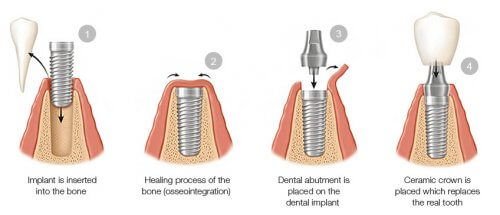Dental Implants
Up until very recently, the only treatments available for missing teeth were bridges and dentures. With the emergence of dental implants, we are now able to permanently restore missing teeth safely and effectively. Dental implants are replacement tooth roots to which replacement teeth can be fastened.
With proper care, dental implants can last a lifetime. If you are missing one or more teeth, your dentist will talk to you about your options. Once you move forward with getting implants, the first step is placing the tooth root implant into the bone socket of the missing tooth. Once the jawbone heals, it grows around the implanted post (typically made of titanium).
Once the jaw is healed and the post is securely anchored, the dentist attaches a small connector post that holds the new tooth. The replacement tooth is then attached to the connector post. From there, the dentist can then attach removable dentures to the implants. Because the implant is secured within the jawbone, your replacement teeth look and feel just like natural teeth and are fully functional.
There are many advantages to dental implants, including:
- Improved appearance. Dental implants look and feel like your own teeth.
- Improved speech. Dental implants allow you to speak without the worry that teeth might slip.
- Improved comfort. Because they become part of you, implants eliminate the discomfort of removable dentures.
In general, if you are healthy enough to undergo a tooth extraction, you may be a candidate for dental implants. Dental technology has come a long way in recent years. It is no longer necessary to suffer without teeth or deal with dentures that don’t feel like natural teeth. If you’re ready to restore your smile, give us a call today!
What are Dental Implants?
Dental implants are tooth root replacements that are surgically implanted into your jawbone. A small, Titanium implant is inserted into your jawbone, which shortly after, your bone will fuse with. Once this happens, a post placed into the implant creates a strong root for an artificial tooth to be attached.
These implants are achieved, usually, in two different surgical procedures. During the first, the implant posts are placed into your jawbone. After this procedure, you continue to wear your dentures for about three to six months while your bone fuses to the implant. Then, once your replacement teeth are created by your dentist, you then have a second procedure where posts are placed into the implant for the artificial teeth to attach to, and your artificial teeth are inserted to those posts.
What Types of Dental Implants are Available?
The most popular types of dental implants that may be required to replace missing teeth: singular implants, dental bridges and implant dentures.
Singular implants are exactly how they sound – implants that replace one missing tooth in your jawbone. Dental bridges are attached to implants to replace more than one missing tooth usually. Dental bridges are not always attached to implants because they can be bonded to existing teeth when the case permits. Implant dentures are replacing all of you permanent teeth and placing 2-4 implants per quadrant to support the denture.
What are the Benefits of Dental Implants?
There are many benefits of the dental implants Grand Avenue Family Dentistry may perform if your case requires. These include restoring your smile, restoring the ability to chew and speak properly, restoring and supporting the natural shape of your face, correcting your bite, and maintaining alignment of your remaining natural teeth.
What is Bone Grafting?
Bone grafting is necessary in cases where missing teeth have created an atrophy of jawbone that was supporting that missing tooth. Because there is no tooth or implant, that jawbone can atrophy or be reabsorbed, which makes the section of jawbone unsuitable for a dental implant. Bone grafting is a procedure that entails inserting new bone in that spot, so a dental implant may be placed. The bone will either be obtained through a tissue bank or your own suitable bone from your jaw, hip, or tibia.
Once the new bone is placed and healed, your jawbone is then ready for a dental implant procedure to restore your missing teeth.
